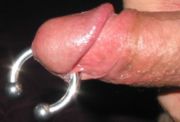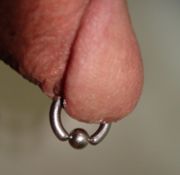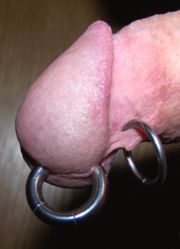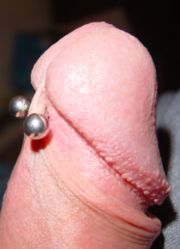Prince Albert

A Prince Albert, also known as PA or sometimes just Albert, is a metal ring worn through a piercing at the end of the penis. It is usually made of surgical steel, but can also be in gold. It is most commonly encountered among gay males, but heterosexual males also use it. The genital hole will usually be formed either on the underside between the urethra and the frenum or through the urethral opening and emerging from the underside of the glans. The ring may be closed by a steel ball.
A nerve bundle runs along the centre of the frenulum. While some piercers may choose to avoid the bundle, others do not. The piercing may be centred if the bearer is circumcised. Otherwise, the piercing will be done to the side because the skin in the area needs to be able to dynamically reposition itself.
Supposedly, Prince Albert, consort of Queen Victoria, wore one, and popularised it among his set.
Jewellery
Prince Alberts are typically pierced at either 10 or 8 GA. In either case, they are often immediately stretched to 8 or 6 GA. The stretching prevents bleeding during the initial healing stages by exerting pressure on the fissure. Outside of this initial stage, they are rarely seen below a 10 gauge (2.6 mm). PAs are sometimes stretched to a 0 or 00 gauge, or about 11/32 inch (8 to 9 mm) diameter. Stretching to sizes of 6 to 2 GA is probably most common.
Very large gauge or heavy jewelry can cause thinning of the tissue between the urethral opening and the healed fistula creating an accidental meatotomy. Conversely, extremely thin jewellery can cause the same tearing in what is commonly referred to as the "cheese cutter effect", either during sudden torsion or over a long period of wearing, especially if the thin jewellery has anything heavy attached to it (gay males tend to add charms to a PA). In some cases this can be corrected surgically. While most wearers find that PAs are comfortable to wear and rarely remove them, even during sex, some individuals might find that extremely large or heavy jewelry is uncomfortable to wear for long periods or interferes with the sexual functioning of the penis.
Jewellery usually worn in a PA includes the circular barbell, captive bead, and the Prince's Wand. Short curved barbells are usually about 3/8 inch or so length, so one ball sits on the lower side of the penis and the other ball sits at the urethral opening. This type of jewelry prevents discomfort that can come from larger jewelry moving around during daily wear.
The Prince's Wand is a particularly unusual piece of jewelry. It consists of a hollow tube with a threaded cap at the end. The tube is inserted into the urethra, and a stem is inserted through the PA piercing and into another threaded hole on the side of the tube. The general shape is similar to a policeman's nightstick. The side stem holds the tube in place. The threaded cap, often just a ball, can be removed so the wearer can urinate through the hollow tube without having to remove the jewelry.
History and culture
The Prince Albert piercing may have been practised in European culture for some time, and while there are many tentative theories as to its origin, the true origin of this piercing is unknown. Many of the theories regarding this piercing's history suggest that the piercing was used to secure the penis in some manner, rather than having a sexual or cultural purpose.
The Prince Albert piercing is often claimed to be named after Queen Victoria's consort, Prince Albert of Saxe-Coburg-Gotha. It is alleged that he wore a ring attached to his penis which was then strapped to his thigh, in order to maintain the smooth line of the tight trousers that were in fashion at the time. It is very difficult to ascertain the validity of this story, and the claim seems highly unlikely. No contemporary account of him adopting the practice has come to light, and many suspect that it was a myth invented by Doug Malloy who helped popularise body piercing in the United States, and who also created much of the false history commonly attached to many body piercings. It has also been theorised that the name actually refers to Queen Victoria's grandson Prince Albert Victor. This second theory probably stems from attempts to link Prince Albert Victor with the Jack the Ripper murders.
Like many other male genital piercings, it has a history of practice in gay culture in the twentieth century and became known outside that culture at the same time that body piercing began to emerge in popular culture in the late 1970s. The relatively easy procedure, rapid healing and claims of additional sexual stimulation (both to the wearer and his partner in sexual intercourse) attributed to this piercing have come to make the Prince Albert the most common male genital piercing. The easiest post-piercing wound-care is to dip the penis into a wineglass of hydrogen peroxide, followed by urination, and then a fresh dip in O2O2.



